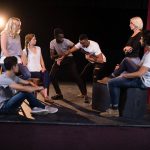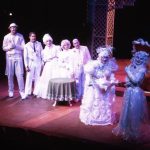Remember the American Idol Experience at Disney’s Hollywood Studios? From 2009 to 2014, guests could live out their singing dreams on a near-perfect replica of the American Idol set. What led to its closure? This article explores the attraction’s initial success, including the coveted “Dream Ticket,” and the factors that ultimately led to its demise. We’ll examine Disney’s learnings about adapting TV shows into theme park attractions and how to create enduring experiences. Fan insights will also guide the next generation of interactive attractions, offering valuable lessons for the future of theme parks. For another example of a themed entertainment experience, check out this similar venue.
Idol Experience: A Theme Park Retrospective – Examining Theme Park Guest Engagement
The American Idol Experience was a bold gamble. It offered guests a chance to step onto a realistic American Idol set, complete with a live band and real judges. For a while, it thrived, allowing everyday people to live out their pop star fantasies. However, like many trends, it eventually faded. Let’s examine why and consider the future of theme park guest engagement.
Its initial success was undeniable. The opportunity to sing in front of a crowd, even a simulated one, was incredibly appealing. The attention to detail was impressive, with a realistic set and constructive feedback from judges. This was more than just a ride. It was a chance to shine.
The “Dream Ticket” Appeal and Its Impact on Future Attractions
A significant driver of the initial buzz was the “Dream Ticket,” a golden ticket to American Idol auditions. This offered contestants a chance to skip the lines and go straight to the real judges, a powerful draw. Several contestants launched their careers thanks to the Dream Ticket, proving its effectiveness as a marketing tool. But could its marketing strategies be implemented in future attractions to recapture that initial momentum?
However, the dream couldn’t last. The high operational costs, including a full-fledged stage production, live band, and state-of-the-art sound and lighting, were a significant burden. Disney likely underestimated these ongoing expenses. A simpler version might have been more sustainable, a point debated by theme park designers.
The Decline of American Idol and the Risks of Pop-Culture Integration
The decline of American Idol‘s popularity also played a role. As the show’s ratings dropped, so did interest in the attraction. Tying the experience so closely to a single brand proved risky. This highlights a crucial lesson: avoid putting all your eggs in one pop-culture basket when designing theme park attractions. What is the long-term viability of attractions tied to quickly trending pop culture?
The Idol Experience was a fascinating experiment in immersive entertainment. It demonstrated the potential for participatory attractions but also highlighted the risks of high-concept endeavors. Although not entirely successful, its impact is undeniable, demonstrating the importance of balancing creativity with financial practicality, diversifying brand strategy, and understanding the shifting nature of trends.
Key Takeaways:
- The immersive and realistic set, combined with live performances, provided high guest engagement.
- High operational costs and reliance on a single, potentially fading brand were major drawbacks.
- The experience underscored the importance of balancing creativity with financial practicality and diversifying brand partnerships.
| Factor | Pros | Cons | Key Lessons Learned |
|---|---|---|---|
| Experiential Authenticity | Immersive, realistic set; live band & professional judges; high guest engagement | Extremely high operational costs; reliance on a single, potentially fading brand | Prioritize cost-effectiveness alongside immersion; explore diverse brand partnerships |
| Guest Participation | High participation; strong “Dream Ticket” incentive; generated many success stories | Dependent on American Idol‘s popularity; potential for participant burnout | Diversify engagement methods; manage expectations; implement effective crowd control |
| Technological Integration | Cutting-edge stage tech enhanced production value; impressive visuals | Limited interactive elements beyond performance; tech may have constrained creativity | Invest in scalable, flexible tech; prioritize user interaction and customization |
The American Idol Experience wasn’t a long-term success, but it left a legacy. It showed the potential of combining immersive technology, talented performers, and a captivating theme. However, it also highlighted the importance of careful planning, sustainable business models, and less dependence on pop culture trends. The lessons from its brief existence continue to influence the theme park industry.
How to Replicate American Idol Experience Success in Theme Park Attractions – Focusing on Sustainable Theme Park Design
The American Idol Experience aimed to bring the reality TV phenomenon to Disney’s Hollywood Studios. It provided a unique opportunity for aspiring singers to audition and compete, even gaining a pathway to the actual American Idol competition. The initial excitement was high, but how did this ambitious project fare, and what lessons can we learn for how to replicate american idol experience success in theme park attractions and ensure sustainable theme park design?
Triumphs: A Story of Active Participation and Creative Marketing in Theme Parks
Several elements contributed to the attraction’s initial success. An immersive environment recreated the feel of the TV show. Talented performers emerged, and the integration of real judges amplified the buzz. Participants were active players in a compelling narrative, a level of engagement rare in theme park experiences. The initial success underscores the power of immersive, interactive attractions. How can innovative concepts be implemented to ensure continued success in creative marketing in theme parks?
Setbacks and the Need for a Realistic Budget for Theme Park Attractions
However, the attraction’s triumphs were punctuated by significant drawbacks. Its reliance on the popularity of American Idol proved to be a fatal flaw. As the show’s popularity waned, so did attendance. The high cost of maintaining a large staff and the complex production created a financially unsustainable model. The six-hour commitment demanded for complete participation created bottlenecks. Furthermore, the simulated harshness of Simon Cowell’s character drew criticism. What is the optimum budget for theme park attractions to sustain its place overtime?
Harmonizing Success: Diversified IP and Efficient Operational Models
The American Idol Experience provides valuable insights. The need for diversified IP is clear. A successful attraction needs a broader appeal rather than relying on potentially fading fads. Efficient operational models are key. Streamlining processes and reducing staffing requirements are essential for long-term viability. Consider automation or scaled-down productions to avoid the pitfalls of the Idol Experience.
Theme Parks and Entertainment
Replicating Success: A Balanced Framework of Theme Park Planning and Promotion
To succeed where the American Idol Experience faltered, future attractions need careful planning. How to replicate american idol experience success in theme park attractions requires a multifaceted approach. It involves focusing on diverse and enduring IP, developing flexible operational models to handle fluctuating demand, and designing experiences that don’t overextend guest time commitments. This balanced approach, combined with creative marketing, will likely result in successful entertainment experiences within the theme park environment. The key is to learn from the past and create experiences that are both captivating and sustainable by improving theme park planning and promotion.
Disney’s Idol Experience: A Case Study in Building an Immersive Theme Park Experience – A Step-by-Step Guide for Themed Entertainment Design
Remember the American Idol Experience? A short-lived, yet fascinating, attempt to translate a wildly popular TV show into a theme park attraction. Let’s dissect its rise, fall, and the invaluable lessons learned for anyone embarking on a similar project within themed entertainment design.
The Dream Takes Shape: Initial Design and Development of a Themed Entertainment Location
The initial concept was brilliant: fans could audition, receive feedback from AI judges, and perform on a virtual stage. This immersive experience aimed to capture the thrill of the actual show. Building an Immersive Theme Park Experience – A Step-by-Step Guide began with a detailed master plan involving spatial planning and smooth guest flow. Early marketing was effective, capitalizing on the existing fan base. But where did it all go wrong in developing a themed entertainment location?
The Cracks Appear: Operations and Technology
However, technology, while innovative for its time, proved unreliable. Technical glitches were frequent, frustrating visitors and undermining the immersive experience. Queue management systems were overwhelmed, leading to extensive wait times. Staff training was insufficient, and employees struggled to handle the high volume of visitors and technical difficulties. The dream faded. What key operational changes were needed when integrating new theme park technology?
Errors in Marketing and Management Led to Closure
Marketing failed to adapt to the negative feedback. The initial excitement waned as reports of malfunctioning equipment and poor customer service spread. Management wasn’t agile enough to respond to these challenges and struggled to make the necessary adjustments. The American Idol Experience became a cautionary tale and a reminder that even the best-laid plans can crumble without ongoing adaptation and proactive problem-solving. How should marketing and management be improved to avoid permanent theme park closure?
The End: Lessons Learned
The American Idol Experience’s closure served as a harsh wake-up call. What can we learn from this ambitious yet ultimately flawed project regarding Building an Immersive Theme Park Experience – A Step-by-Step Guide? It highlights the need for robust technology, thorough staff training, and effective contingency planning. It also underscores the importance of continuous monitoring, data-driven adjustments, and a strong commitment to guest satisfaction.
Key Takeaways:
- Thorough testing of technology is paramount.
- Unlock Your Potential with Adult Vocal Lessons at Any Age - January 8, 2026
- Adult Voice Lessons Transform Your Singing and Build Confidence - January 7, 2026
- Vocal Performance Artistry Requires Unmatched Control and Emotional Depth - January 6, 2026










